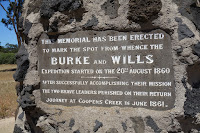One of my "thinker in residence" sponsors here in Australia is VMIA, the Victoria state government insurance agency. I had just finished having a lovely cup of coffee and conversation with one of the agency's executives, where our topic had been risk assessment and mitigation.
As I started to leave the coffee shop (not a state agency facility!), I stumbled and looked back to see a drop in the floor levels between two parts of the restaurant. While I can be clumsy (just ask my soccer buddies!), usually I'm pretty adept at walking out of restaurants without suffering harm. So, I looked back to reconstruct the situation.
Here's the broad scene. The waiter above has just stepped down into the lower portion of the shop. And indeed, there is a large sign up and to the right warning patrons of the drop in floor height.
The problem is a that there is a very eye-catching sign to the left, designed to draw your attention as you pass through this area.
So, I didn't notice the warning sign to my right. Also, the floor area is not well lit, and there is little color difference between the step and the floor below.
Ok, that's the human factors set of circumstances. These are accidents waiting to happen.
Now, let's turn to the people side. As I stumbled, a clerk behind the counter noticed and smiled knowingly, as if to suggest that I was not the first to have this experience. I went back to talk with another clerk and point out the problem. She was very apologetic and asked if I was hurt. I said I was fine but just wanted to point out the safety hazard. When she saw me taking pictures, she said, "You're not going to sue us, are you?" I said no, but I thought the shop might want to devise a better warning system. She acknowledged that the current arrangement was designed to warn people headed towards the right, i.e., going to the toilet, but not those who might be going to the left.
I left confident that the problem would not be addressed in the future. Some day, someone will fall and be badly hurt, and the shop may, indeed, be sued.
Think through similar circumstances in health care facilities and other service establishments, as well as industrial settings. Such patterns are highly prevalent--both in terms of the human factors issues and also in terms of the lack of empowerment felt by the front line staff.
As I started to leave the coffee shop (not a state agency facility!), I stumbled and looked back to see a drop in the floor levels between two parts of the restaurant. While I can be clumsy (just ask my soccer buddies!), usually I'm pretty adept at walking out of restaurants without suffering harm. So, I looked back to reconstruct the situation.
Here's the broad scene. The waiter above has just stepped down into the lower portion of the shop. And indeed, there is a large sign up and to the right warning patrons of the drop in floor height.
The problem is a that there is a very eye-catching sign to the left, designed to draw your attention as you pass through this area.
So, I didn't notice the warning sign to my right. Also, the floor area is not well lit, and there is little color difference between the step and the floor below.
Ok, that's the human factors set of circumstances. These are accidents waiting to happen.
Now, let's turn to the people side. As I stumbled, a clerk behind the counter noticed and smiled knowingly, as if to suggest that I was not the first to have this experience. I went back to talk with another clerk and point out the problem. She was very apologetic and asked if I was hurt. I said I was fine but just wanted to point out the safety hazard. When she saw me taking pictures, she said, "You're not going to sue us, are you?" I said no, but I thought the shop might want to devise a better warning system. She acknowledged that the current arrangement was designed to warn people headed towards the right, i.e., going to the toilet, but not those who might be going to the left.
I left confident that the problem would not be addressed in the future. Some day, someone will fall and be badly hurt, and the shop may, indeed, be sued.
Think through similar circumstances in health care facilities and other service establishments, as well as industrial settings. Such patterns are highly prevalent--both in terms of the human factors issues and also in terms of the lack of empowerment felt by the front line staff.















































